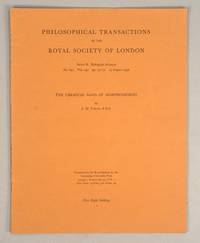
THE CHEMICAL BASIS OF MORPHOGENESIS
by TURING, Alan
- Used
- first
- Condition
- See description
- Seller
-
Jamaica Plain, Massachusetts, United States
Payment Methods Accepted
About This Item
1952. ALAN TURING'S MOST CITED WORK TURING, Alan. "THE CHEMICAL BASIS OF MORPHOGENESIS." A fine first-edition offprint from the Philosophical Transactions of the Royal Society of London, Series B. Biological Sciences, No. 641, Vol. 137, pp. 37-72, 14 August 1952. Published for the Royal Society by the Cambridge University Press, London. Publisher's 1952 offprint, with "Price Eight Shillings" on cover. Many mathematical equations and two figures in text. Quarto, 30 x 23.5 cm, publisher's brick wrappers, title information to upper wrap and spine. Fine. In this, Alan Turing's most heavily-cited work, the pre-eminent mathematician, computer scientist, and hero of WW II turned his brilliant mind towards the biological sciences, proposing a model of pattern-formation that proved seminal in not only biology but also across many scientific fields. In what would be his only published work in the field, Turing addressed a fundamental problem: morphogenesis, the process by which a single cell develops into the complex, asymmetrical organisms found in nature. Turing designed a simple family of models in which stable initial distributions of change-creating chemicals called morphogens (this work introduced the term to the scientific lexicon) become unstable in the presence of any diffusion process, such as the mixing of fluids found in living tissue. Using this elegant diffusion-reaction system, understandable with college-level mathematics, Turing explains the asymmetric pattern-formation of living organisms starting from a simple early state, providing a mathematical justification for everything from the dappling of fur and seashells, the tentacle-like appendages of Hydra organisms, to the separation of the nervous system during embryonic development (gastrulation). This ground-breaking work has formed the basis for a broad array of advances in biology, from models of tumor growth, epidemic spread, and evolutionary biology, to the shapes of neuronal dendrites and neuronal polarization. Outside of the biological sciences, this paper has inspired advances in areas as diverse as the behavior of sensor networks, image processing, economic geography, spatial ecology, and machine learning models for computer vision. The universality of this pattern formation model is perhaps unsurprising given Turing's polymathy, and no less magnificent.
Reviews
(Log in or Create an Account first!)
Details
- Bookseller
- Boston Book Company
(US)
- Bookseller's Inventory #
- 89800
- Title
- THE CHEMICAL BASIS OF MORPHOGENESIS
- Author
- TURING, Alan
- Book Condition
- Used
- Quantity Available
- 1
- Date Published
- 1952
- Weight
- 0.00 lbs
Terms of Sale
Boston Book Company
15 day return guarantee, with full refund including shipping costs for up to 15 days after delivery if an item arrives misdescribed or damaged.
About the Seller
Boston Book Company
About Boston Book Company
Established in 1979, Boston Book Company offers rare and interesting books in a broad range of subjects. Our areas of particular expertise: Japanese artist books of all eras, East Asian art in general, photographica, local history, women's books, English and American literature..
We are always eager to learn something new.... Every collector brings a novel approach to our shared love of books.
Welcome!
Helen Kelly
Charles Vilnis
David Fredette
James Desrosiers
Elizabeth Fragala
Glossary
Some terminology that may be used in this description includes:
- Fine
- A book in fine condition exhibits no flaws. A fine condition book closely approaches As New condition, but may lack the...
- Spine
- The outer portion of a book which covers the actual binding. The spine usually faces outward when a book is placed on a shelf....
- Offprint
- A copy of an article or reference material that once appeared in a larger publication.
- Quarto
- The term quarto is used to describe a page or book size. A printed sheet is made with four pages of text on each side, and the...
- Wrappers
- The paper covering on the outside of a paperback. Also see the entry for pictorial wraps, color illustrated coverings for...






